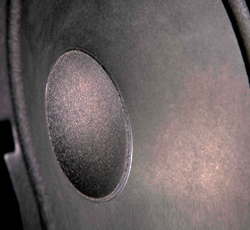
An Exception
I have to mention that there’s one exception to all of the above: trance music. By this I mean dance music, rave music, some kinds of techno music, and generally any kind of music that’s designed to produce an altered state of consciousness by physical bombardment of the body and senses.
If you’re into that kind of thing, then you want your bass to have a stunning effect. Such an effect is produced when each bass transient is accompanied by a blast of harmonics that shakes the room, dims the lights, masks the music, and makes people’s eyes go blurry.
If that’s what you’re after, then you’ll probably want high-distortion bass. The easiest way to get that is to use nonlinear woofers. To get more control over the phenomenon, you can use bass-distorting devices, including subharmonic generators and other evil machines.
Lots of Bass
Even outside the trance community, lots of people like lots of bass. Me, for example—I like lots of bass. But if we’re not using distortion to create the illusion of powerful bass, what then do we do? The answer is: have lots of bass headroom. If you have plenty of bass output capability, then when a real bass note comes along the system can put it out with integrity.
In other words, if you’ve really got it, you don’t have to fake it. But how do you get enough bass headroom and still stay within reasonable space and budget limits?
The answer: use efficient woofers. Most concert woofers are not really efficient enough to provide sufficient headroom for today’s music with today’s budgets.
Frequency Response
How low should your bass go? Here are low-frequency limits of some common musical instruments:
Four-string electric bass—-40 Hz
Five-string electric bass—-30 Hz
Standup (double) bass—-40 Hz
Normal grand piano—-27.5 Hz
Bass singer—-62 Hz
Ordinary large pipe organ—-16 Hz
Kick drum (approximately)—-60 Hz
What this table doesn’t say is where the most important frequencies of these instruments are. For a lot of bass instruments, the harmonics are louder and more important than the fundamental frequencies.
Being of higher frequency, the harmonics are more easily and quickly heard by the ear, and often contain the bulk of the melodic and rhythmic information. What we’ve found for most popular music, the most important part of the musical range is from about 60 Hz up.
The range from 40 to 60 Hz is good for enhancing the experience, but only IF you have the 60-100 Hz range working well, and if you know how to manage the energy in your mix to avoid reverberation problems in big rooms.
Useful musical content below 40 Hz is rare in concert work. It occasionally is needed for acts that feature heavy synthesizer bass. These frequencies don’t work very well with popular music in typical large concert venues.
In their endless quest for impressive specs, loudspeaker manufacturers always seem to be building woofers that put out tons of 35 to 45 Hz at the expense of fidelity and output from 60 to 100 Hz. Such woofers move a lot of air, but sound ugly.
